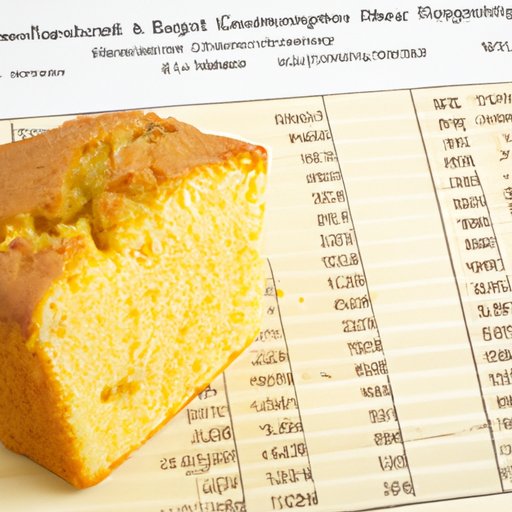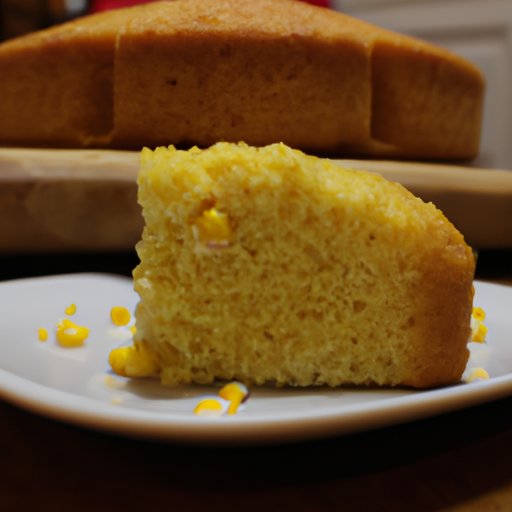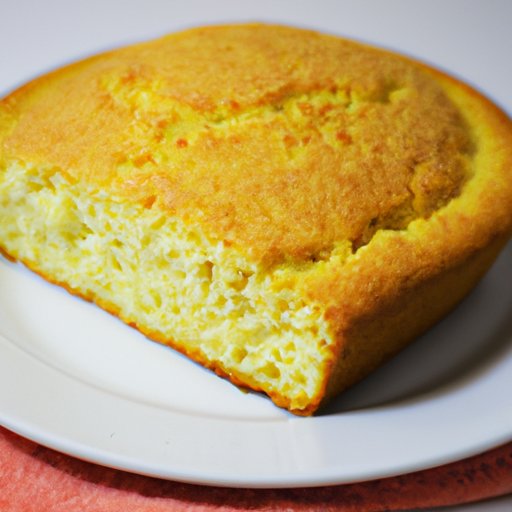Introduction
Cornbread is a type of bread made from ground corn, also known as maize. It is popular in many cultures around the world, including the United States, Mexico, and parts of Africa. In recent years, it has become increasingly popular as a health food due to its high fiber content and gluten-free status.
In this article, we will explore the nutritional profile of cornbread and examine the potential health benefits and risks associated with eating it. We will also compare it to other grain-based foods and look at traditional recipes for cornbread to see how different preparation methods can affect its healthfulness.

Examining the Nutritional Profile of Cornbread
The nutritional profile of cornbread varies depending on the ingredients used and the recipe followed. Generally, one slice (1/10 of a 9-inch round cake) contains between 130 and 170 calories, 24 to 28 grams of carbohydrates, 3 to 4 grams of fat, 4 to 6 grams of protein, and 2 to 4 grams of fiber.
Cornbread is also a good source of vitamins and minerals, such as thiamin, riboflavin, niacin, vitamin B6, folate, iron, magnesium, phosphorus, potassium, and zinc. It also contains small amounts of calcium and vitamin A.

Exploring the Benefits and Risks of Eating Cornbread
Eating cornbread can have both potential health benefits and risks. Let’s take a closer look at each one.
Potential Health Benefits
One of the main benefits of eating cornbread is that it is a good source of fiber. Fiber is an important nutrient that helps keep your digestive system healthy and can help lower cholesterol levels. According to a study published in Nutrition Reviews, diets high in fiber may also reduce the risk of heart disease, stroke, and type 2 diabetes.
Cornbread is also a good source of complex carbohydrates, which provide slow-burning energy throughout the day. Complex carbohydrates are also important for brain function, as they help the body produce serotonin, a neurotransmitter responsible for feelings of happiness and relaxation.
Potential Health Risks
Although cornbread is generally considered a healthy food, some types of cornbread contain unhealthy ingredients, such as added sugar and saturated fats. Eating too much of these types of cornbread can increase your risk of obesity and other chronic diseases.
Cornbread is also a source of phytic acid, which can bind to essential minerals such as iron and zinc, making them less available for absorption by the body. Therefore, it is important to pair cornbread with other nutrient-rich foods, such as legumes, nuts, and seeds, to ensure you are getting adequate amounts of these important nutrients.
Comparing Cornbread to Other Grain-Based Foods
When compared to other grain-based foods, such as white bread and pasta, cornbread has a slightly different nutritional profile. One slice of cornbread typically contains fewer calories than one slice of white bread or one serving of pasta, but more protein and fiber.
Both cornbread and white bread are sources of complex carbohydrates, but cornbread is higher in fiber and contains fewer processed grains. It is also naturally gluten-free, making it a good option for those with gluten sensitivities or allergies.
Investigating Traditional Recipes for Cornbread
Traditional recipes for cornbread vary by region and culture. Most recipes call for cornmeal, baking powder, salt, and milk, although some recipes may include additional ingredients, such as eggs, butter, oil, honey, or sugar.
Traditionally, cornbread is made by combining the dry ingredients in a bowl, adding the wet ingredients, stirring until combined, and then baking in a hot oven. Some recipes may call for frying the cornbread in a pan on the stovetop.
Exploring How Different Preparation Methods Affect Cornbread’s Healthfulness
The way you prepare cornbread can have an effect on its healthfulness. For example, baking cornbread instead of frying it can reduce the amount of fat and calories it contains. Additionally, using whole grains instead of processed grains can increase the fiber and nutrient content.
Using oil or butter in your cornbread recipe can also affect the healthfulness of the final product. Using unsaturated fats, such as olive oil or avocado oil, can increase the nutritional value of the cornbread and make it a healthier option. Adding sugar or honey to the recipe can also add calories and sugar without adding any nutritional value.
Conclusion
Cornbread is a popular food staple in many cultures around the world. While it is generally considered a healthy food, the nutritional profile of cornbread can vary depending on the ingredients used and the recipe followed. It is important to keep in mind that some types of cornbread can be high in fat, sugar, and calories and should be eaten in moderation.
In general, cornbread is a good source of fiber and complex carbohydrates, as well as vitamins and minerals. It is also naturally gluten-free, making it a good option for those with gluten sensitivities or allergies. To ensure you are getting the most nutritional value from your cornbread, opt for recipes that use whole grains, unsaturated fats, and minimal added sugar.
By following these guidelines, you can enjoy cornbread as part of a healthy diet.
(Note: Is this article not meeting your expectations? Do you have knowledge or insights to share? Unlock new opportunities and expand your reach by joining our authors team. Click Registration to join us and share your expertise with our readers.)
